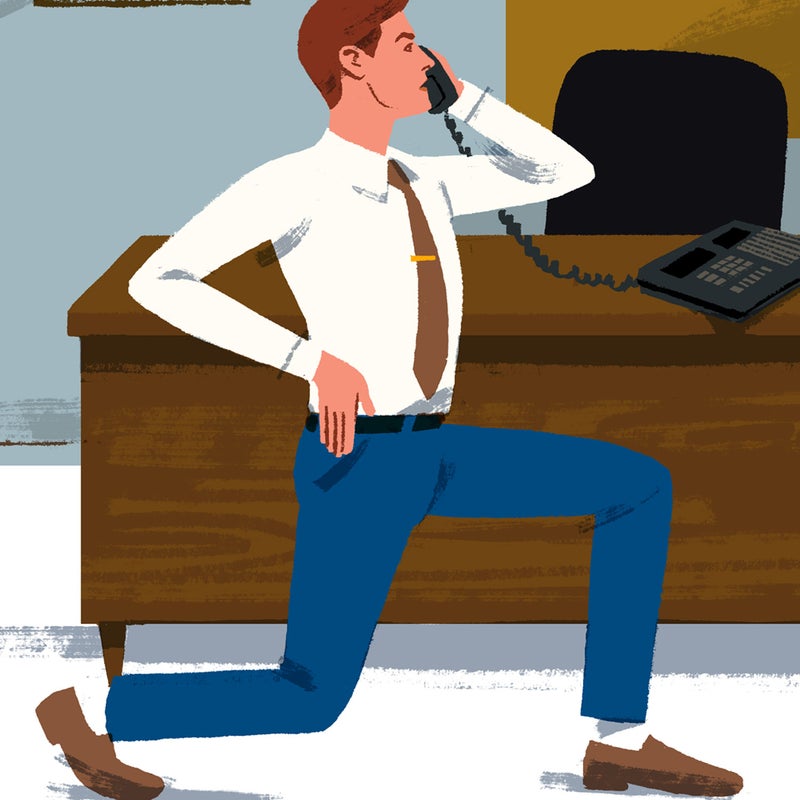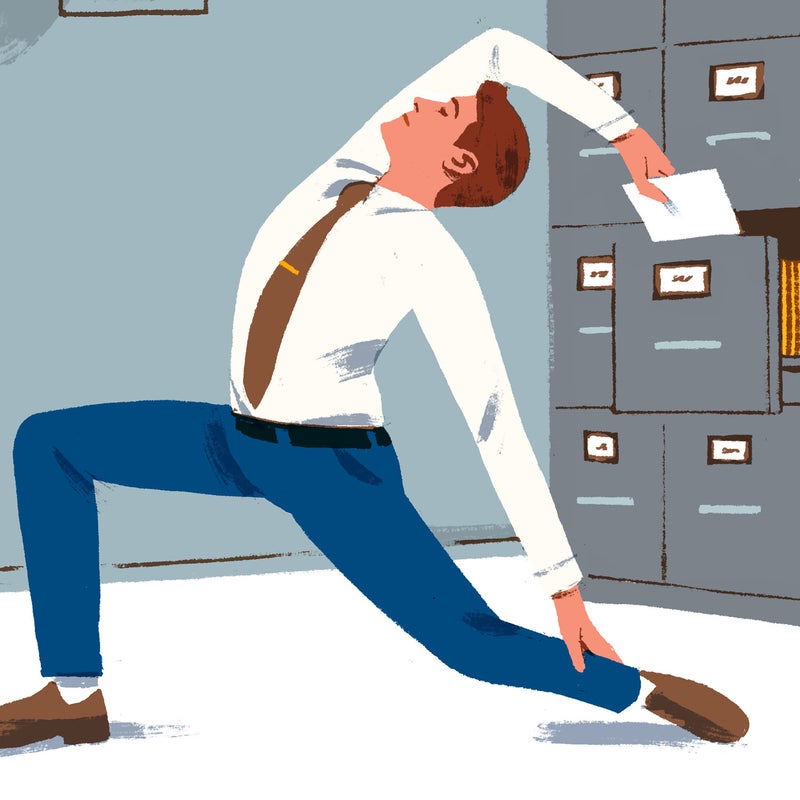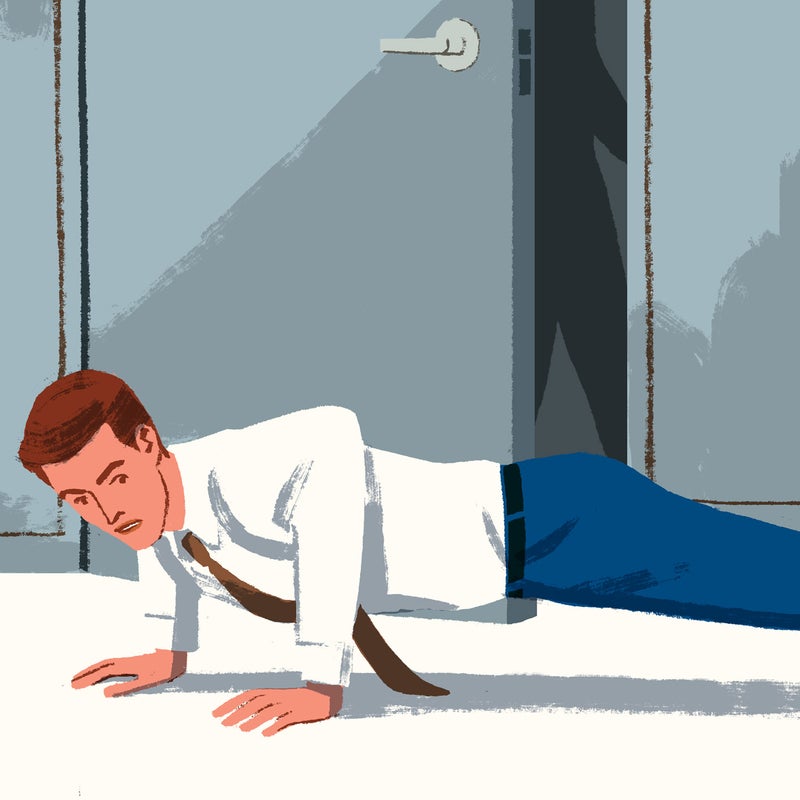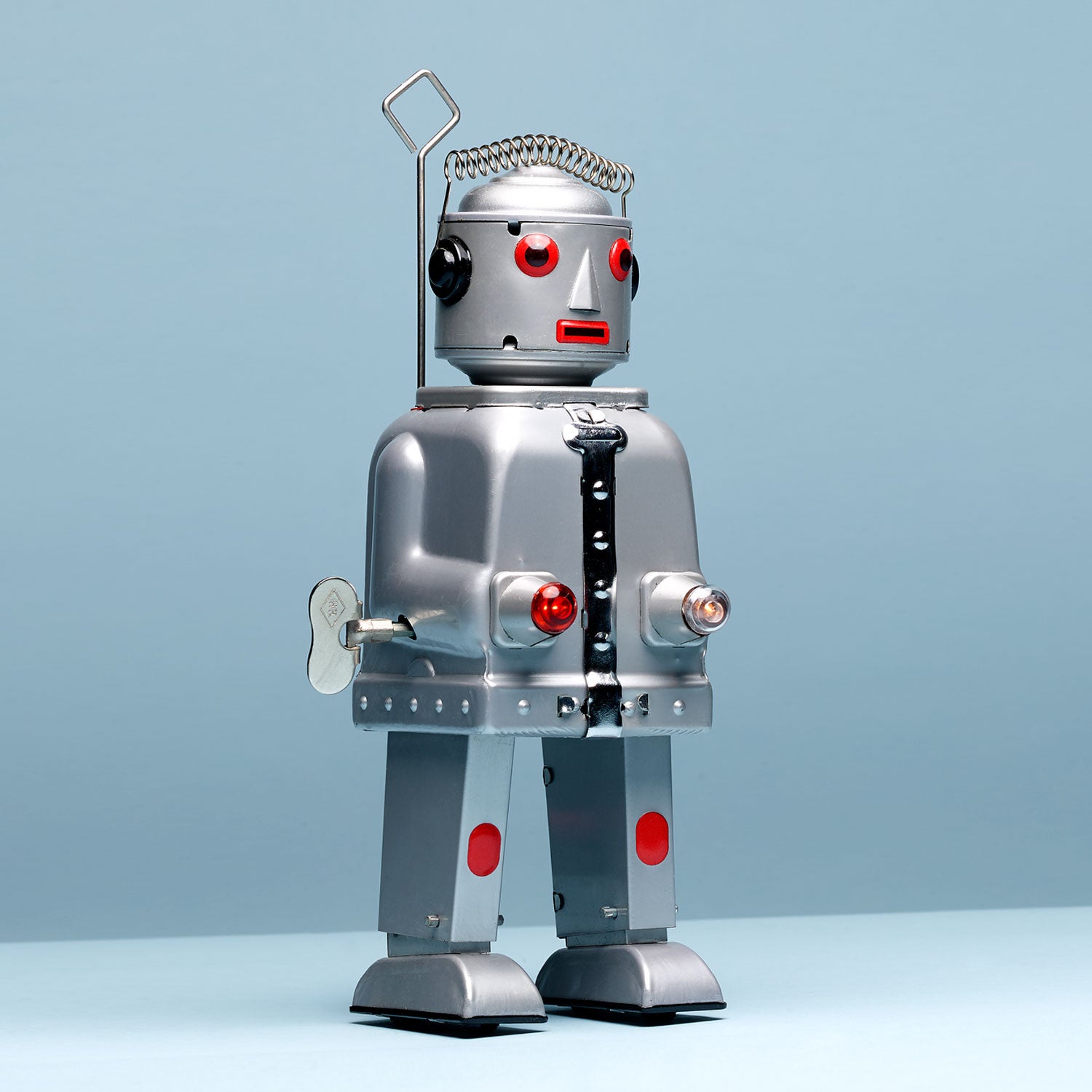A few years ago, , a doctor of endocrinology at the Mayo Clinic, sparked a radical change in America’s office furniture. His research had inspired a pile of viral stories cataloging the negative effects of sitting at a desk: leg muscles shut down, blood pressure increases, good cholesterol plummets, your children starve. OK, I made up that last one, but the real takeaway was no less dire. “Excessive sitting is a lethal activity,” Levine, who has studied sedentary behavior for nearly 20 years and is the most widely quoted expert on the topic, . And the solution—at least the one people heard—was to start standing.
Cue the office makeovers. Over the next several years, workers all across America embraced stand-up desks. At �����ԹϺ���’s headquarters in Santa Fe, our building manager furiously reconfigured work spaces. Desks were removed from their shelving brackets, raised a foot and a half, and remounted. Walking the hallways, I’d do double takes every time I realized that another editor had taken a stand against sitting. Close to half our offices were eventually converted. Good science had spurred a small change that was dramatically improving our health. We were literally rising from the dead!
Or were we? The stand-up revolution was followed by another wave of stories reporting that being on your feet in the same place all day has its own downsides, including increased risk of cardiovascular problems. What’s more, at least at �����ԹϺ���, few people’s habits really changed. This morning, I took a tour around our building to assess our commitment to stand-up desks. In 14 of the converted spaces, editors were either hunched over on stools or perched on chairs that they had elevated to meet the new level. They were still sitting, only higher. In a half-dozen other cases, people had simply lowered their desks back to their old positions.
When I called Levine and told him what had happened at �����ԹϺ���, he let out the sigh of a man who’d heard all this before. “It’s not the furniture that makes the difference, it’s the behavior,” he said. “The desk without the behavior doesn’t help you.”

In other words, we missed the larger point that Levine and his colleagues were trying to convey. The solution to sitting isn’t to stand, though it helps. In fact, according to the findings of a 2015 consensus panel on the topic, we need to be on our feet two to four hours while at work. But the real solution is to move. All day. The stillness is what’s killing us. We should be pacing the hallways and climbing stairs and squatting and lunging and stretching.
Now that requires a radical change, one exponentially more difficult than putting your desk on stilts. But aiming for more movement might also be the most important habit you adopt from an issue of �����ԹϺ��� packed with 72 pages of fitness advice. This is especially true if, like me, you exercise vigorously each day and therefore consider yourself healthy. Researchers have shattered that idea. I might run for an hour every weekday morning, but studies show that if I then go to work and sit at my desk for epic stretches, which I do, I am no more immune to the side effects of sedentary living than the prototypical couch potato.
The solution to sitting isn’t to stand. It’s to move. All day. The stillness is what’s killing us. We should be pacing the hallways and climbing stairs and squatting and lunging and stretching.
When I accepted this scary conclusion, I realized how difficult moving really is. I’m not like my ancestors who worked on a farm where motion was an all-day requirement. My job seems specifically designed to keep me wasting away in a chair. A phone and a computer allow me to communicate and conduct business with nearly any writer on earth without leaving a two-foot radius.

Then there’s the fact that, as Levine put it, “people don’t like change.” In one of his more recent studies, subjects who agreed to take on a rigorous regimen to move throughout their workday saw an initial spike in stress levels. Not surprisingly, the repeated prompts from researchers to exercise were pissing them off. Eventually, those subjects who managed to stick with the plan experienced an overall decrease in stress—and, corporate-HR types should note, a 15 percent increase in productivity. But therein lies another challenge. How do you actually stick with a two-hour movement plan without a team of researchers to keep you honest? Especially when you consider what might be the biggest hurdle of all: the public embarrassment. Moving all day requires one to willfully perform lunges and complex yoga stretches and push-ups in a place where such behavior seems loony. “Getting off your bottom is almost forbidden,” said Levine. “We have to have environments that send the right message.”
Still, I was determined to be the guy who changed his behavior. (Writing this article was a great motivator.) It didn’t go so well at first. I arrived at work determined to move more, but once I sat at my desk, old habits glued me to the computer and I forgot all about my intentions. So I placed a sticky note on my office door that said FARTHER, a little prompt reminding me to use the facility most distant from me every time I needed a drink of water or bathroom break. I also connected my computer to the printer downstairs and across the building. And rather than sending e-mails or using the phone, I tried to go directly to colleagues’ offices.
Once I had those tricks nailed, I got some digital help. There are dozens of fitness wearables that can remind you to move, from the basic step counter to the fully loaded Apple Watch. Instead, I went with a free phone app called Move. [Editor’s Note: Since this story first published, the Move app has been discontinued and is unfortunately no longer available] It buzzes every 45 minutes and assigns me a random exercise: say, 20 body-weight squats or 15 push-ups. These alerts initially drove me crazy. (Again?!) And their commands can be cloyingly phrased: “It’s time to move it, move it.” But eventually I welcomed the interruptions. I noticed that I felt refreshed when I returned to my desk, like I’d rebooted my clogged circuitry.

And the embarrassment? I haven’t exactly been a bold office revolutionary. Instead, I’ve meekly learned to be a stealth mover. Now I either find ways to look like I’m doing something perfectly normal or I make sure I don’t get caught. I do push-ups with an ear cocked toward the door, listening for approaching footsteps. I do wall sits in a corner that no one can see from the hallway. While I’m on the phone, I pace as if I’m carefully deliberating vital magazine business. At my desk, I do inconspicuous yoga poses with names like seated eagle and hip opener. I do laps around the building carrying papers to look as if I’m going somewhere, when all I’m really doing is walking in a large, 223-step circle back to my office. (If you want the full log from a recent day, see “Self Pro Motion,” below.)
Am I happier? Less stressed? More productive? Any conclusions I draw from my experiment would be based on anecdotal evidence, the enemy of real research. But here’s what’s certain: if I continue to squeeze in an extra hour or two of movement each day, I’ll be significantly healthier in the long run. That’s the takeaway Levine and his colleagues need us to hear.
If you want to dedicate yourself to a lifetime of good habits, don’t start at the gym. Start at the office.
What Three Hours of Daily Movements Looks Like
7 a.m.
Morning run (45 minutes)
8:30 a.m.
Walk to coffee shop (10 minutes)
9:15 a.m.
25 push-ups (1 minute)
10 a.m.
Wall sit (2 minutes)
Walk around the building plus three flights of stairs (5 minutes)
10:45 a.m.
20 body-weight squats (2 minutes)
Trip to far water fountain (3 minutes)
11:30 a.m.
Pick up papers at printer plus two flights of stairs (4 minutes)
12:15 p.m.
25 push-ups (1 minute)
15 side lunges, each leg (2 minutes)
Plank pose (2 minutes)
Pacing during phone call (10 minutes)
1 p.m.
Walk around building for quick meetings (10 minutes)
Desk yoga: hip openers, seated eagles, spinal rotations, shoulder stretches (5 minutes)
2 p.m.
25 push-ups (1 minute)
2:30 p.m.
Walking meeting (45 minutes)
3:30 p.m.
15 Hindu push-ups (1 minute)
20 side leg raises (1 minute)
4:15 p.m.
Chair pose (1 minute)
20 body-weight squats (2 minutes)
Walk around the building (5 minutes)
5 p.m.
Plank pose (2 minutes)
20 burpees (2 minutes)
5:45 p.m.
Walk around building plus four flights of stairs (5 minutes)
Not tracked: Walking to and from the car, roaming the grocery store, playing with my kids, etc.
Christopher Keyes () is the editor of �����ԹϺ���.



 127 radical tips for total health.
127 radical tips for total health. On-the-go fitness tools for athletes.
On-the-go fitness tools for athletes.